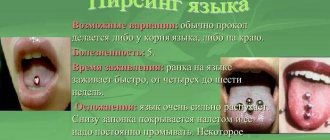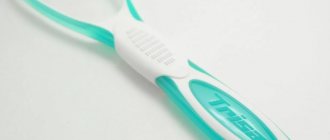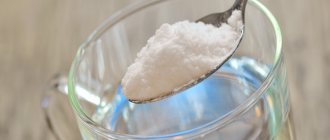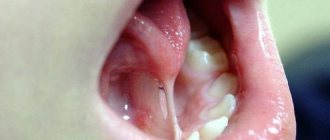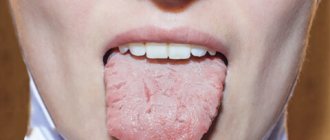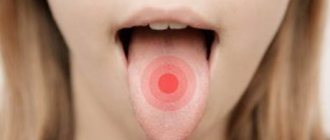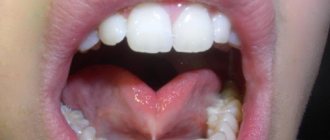White coating on the tongue is a layer of organic substances, bacteria and dead cells, accompanied by swelling of the papillae of the tongue, which can indicate various diseases of the lungs, kidneys or gastrointestinal tract: gastritis, stomach ulcers, enterocolitis.
Plaque on the tongue is a common phenomenon, which many consider simply a feature of their body. And they often forget that you need to brush not only your teeth, but also your tongue. However, many do not know that the appearance of plaque is a symptom usually associated with digestive problems. And it is necessary not only to regularly clean off plaque, but to find the root of the problem and select the appropriate treatment.
If you do not undergo treatment and do not carry out oral care procedures daily, the tongue looks as if it is burned, and bad breath appears. The correct treatment is prescribed by the doctor after testing, and we will try to figure out how to remove plaque from the tongue.
Why do you need to clean your tongue?
When considering the question of how to get rid of white coating on the tongue, you need to start with the basics. The tongue of a healthy person should have a pink color, the surface should be elastic and slightly moisturized. At the same time, a light white coating is not considered a pathology, and this nuisance can be easily eliminated by ordinary cleaning. It's another matter when a strong coating appears. This may indicate the presence of a serious disease in the body.
Cleaning your tongue from plaque at home helps solve the following problems:
- Reduces the concentration of pathogenic bacteria in the oral cavity;
- Prevents the appearance of tartar and caries;
- Freshens breath;
- Improves the functioning of taste buds.
Why does plaque form?
Plaque can accumulate for various reasons. The main ones include:
- decreased immunity;
- untreated oral diseases;
- infections;
- gastrointestinal diseases;
- helminthiasis;
- pathologies of the cardiovascular system;
- respiratory system diseases;
- problems with the thyroid gland;
- fungal infections;
- taking certain medications.
If the immune system is weakened, the body is more susceptible to harmful bacteria.
One of the most common causes of the formation of white plaque is gastrointestinal diseases. As the disease progresses, the plaque becomes grayish or brownish in color. Plaque can accumulate due to fungal infections. Until the source of the damage is eliminated, it will not be possible to get rid of the plaque. A similar thing happens with influenza, whooping cough and other similar diseases. In this case, the following symptoms are added to the plaque:
- enlarged and painful cervical lymph nodes;
- skin rashes;
- redness of the throat;
- enlarged tonsils.
Some foods may change the color of the film on the tongue. Such foods and drinks include beets, ink, strong tea and coffee. This plaque can be removed by regular mouth rinsing. Taking certain medications affects the balance of oral microflora and promotes plaque deposition. For example, this applies to antibiotics. After treatment is completed, deposits stop accumulating on the mucous membrane.
Reasons for appearance
Why does white plaque appear? The main reason lies in food debris that gets stuck between the lingual papillae. As a result, a favorable environment is created for the proliferation of bacteria. Most of these microorganisms die, but do not disappear without a trace. When in contact with saliva and epithelial particles, they stick to the tongue, forming a plaque. In this case, this plaque is partially removed by salivation. The film usually remains in hard-to-reach places, for example, at the root of the tongue. If it is not cleaned in time, it begins to spread to other areas, gradually covering the entire tongue. Considering that these are the remains of bacteria, the likelihood of developing dental diseases increases sharply.
Dental removal techniques
These can be both primitive options and high-tech procedures. The choice of intervention method depends on the following factors:
- the patient's well-being;
- clinical picture (thickness, structure and density of the layer);
- age category;
- localization of formations.
It is acceptable to use several types in combination. They will serve as a supplement and speed up getting a positive result.
Ultrasound for removing solid deposits
How to remove plaque from teeth, from interdental spaces and other hard-to-reach places? The ultrasound method comes to the rescue. The waves crush the hardened layer, and then the broken off particles are washed away with water.
This method is suitable for cleaning both internal and external surfaces, areas between crowns. The structure of the incisors, canines and molars does not suffer from this procedure, however, if the patient has increased sensitivity, or there were too many layers, some discomfort may be felt for several days after visiting the dental office.
Laser removal
The laser beam removes the old stone absolutely painlessly by evaporating water into it. The tooth surface remains intact and is not damaged, the condition of the gums improves due to their tone. An additional advantage of the technique is its disinfecting (antibacterial) effect. There is also a drawback that may seem significant to some, but may not matter to others - it is high cost.
Manual removal
A classic option that has been used for decades. Hard deposits are torn off or scraped out with special devices - curette hooks.
This method in itself is traumatic, especially if the hardened layer has penetrated deep into the subgingival space. However, in some cases, this processing option is the only acceptable one due to certain contraindications and restrictions.
The patient may experience pain or other discomfort. To alleviate the condition, the doctor pre-treats the mucous membranes with a gel or anesthetic spray.
Chemical method
How will you clean your teeth from plaque in this case? The procedure can be used independently or in combination with others. More often, dentists choose the second option, and after chemical treatment they use laser, ultrasound or mechanical cleaning.
The essence of this technique is to apply a special gel-like composition with active ingredients (hydrochloric acid, hydrogen peroxide, etc.) to the surface of the enamel. A reaction occurs as a result of which the deposits are softened and washed away with water or removed manually using special tools.
Gentle Air-Flow sandblasting
Air-Flo is a method that is optimal in the presence of soft layers and a thin bacterial film. This way you cannot get rid of the hard stone.
During the procedure, the units are treated with a mixture of water, air, and special abrasives in powder form. The composition is supplied under a certain pressure.
Based on the results of medical manipulations, the overgrown layer is easily removed, without affecting the structure of the incisors, canines and molars, even if they are milk teeth. Patients who have chosen this technique note an undeniable advantage - the shade of the enamel becomes several tones lighter than before.
Signs of plaque on the tongue
Tongue plaque can be a physiological phenomenon or a side symptom of a serious disease. In the first case, you can remove the white coating on the tongue yourself, without going to the dentist. In the second, you will need the help of a qualified specialist. A white tongue can directly indicate a fungal infection or dehydration of the body
Physiological signs:
- Uniform white or yellowish color;
- A thin layer through which the lingual papillae are clearly visible;
- No unpleasant odor, pain, or other symptoms;
- Appears for certain reasons, for example, due to thirst;
- Easy to clean with a toothbrush.
Pathological signs:
- Dense consistency, difficult to remove;
- Unhealthy color: yellow, brown, gray;
- Covers the entire surface of the tongue;
- Accompanied by an unpleasant odor;
- A sour or bitter taste appears in the mouth.
How effective are traditional methods?
Some people don’t think about how to remove plaque from their teeth, remove it from their gums, and not harm themselves. In pursuit of a snow-white smile, methods are used, the use of which leads to more serious consequences. For example, many often turn to soda, salt, and activated carbon. All of these are abrasives. Dentists do not advise getting carried away with such cleansing options and carrying out the procedure frequently, since hard particles of different sizes scratch the enamel. As a result, it is gradually destroyed, the pathological process affects deeper layers, and caries occurs.
Traditional recipes show good results if the formations are soft. They cannot cope with stone: only a doctor can remove petrified structures.
How to remove plaque from the tongue at home
How and with what to clean the tongue of an adult? There are several ways to quickly deal with this problem. Let's look at each of them in more detail.
Scrapers
These are special loop-shaped devices made of hygienic plastic. Scrapers effectively remove plaque without causing discomfort or gag reflexes. The tool must be moved from the base of the tongue to the tip until the film disappears. After this, the mouth can be rinsed with an antibacterial solution.
Toothbrushes
Most models have special pads on the back surface or removable attachments for removing plaque. Hygienic procedures are carried out according to the scheme discussed above. To enhance the effect, you can apply a small amount of toothpaste to the surface of the nozzle.
Irrigators
These are modern devices for comprehensive oral care. The essence of the irrigator’s work is the directed supply of a stream of water, which gently but effectively removes food debris and plaque on tooth enamel and tongue. Irrigators work very delicately, the possibility of damage to the mucous membrane is completely eliminated. In this case, to enhance the effect, water can be replaced with a medicinal liquid with an antibacterial or anti-inflammatory effect.
Spoons
Sold in pharmacies, in appearance they resemble a small spatula with rounded edges. Thanks to this form, the possibility of injuring the tongue is eliminated.
Special spoon attachments are available for irrigators. For example, a replaceable nozzle TS-100E. This instrument is recommended by dentists for daily hygiene procedures; it effectively removes plaque and helps freshen breath.
Rinse
To clean the tongue, decoctions based on medicinal herbs and plants are used:
- Oak bark;
- Propolis;
- Calendula;
- Sage.
However, it is important to understand that it will not be possible to remove plaque with the help of decoctions alone. This method cannot replace mechanical cleaning and is used rather for preventive purposes.
Cleaning accessories
If you mainly use a brush for dental hygiene, there is a whole cleaning kit for your tongue.
Brush
You can remove plaque buildup with a standard toothbrush. If you are afraid of discomfort, you should choose a device with ultra-soft bristles. Modern dentistry recommends using a special brush for cleaning the tongue with a ribbed surface on the back side. This device makes the procedure painless and safe.
Scraper
A tongue scraper is very convenient because it can cover a larger surface area at once than other tools. This avoids the risk of a gag reflex. It is usually made of plastic in the form of a spoon on a handle.
After the procedure, the scraper must be washed thoroughly. Like other devices, it needs to be changed from time to time.
Spoon
A tongue cleaning spoon is an excellent tool for removing thick plaque and bad breath. The shape of the spoon is an elastic handle with a tip. Use this device after brushing your teeth.
Whatever device you use, it should be individual for each family member.
How to properly clean your tongue with a toothbrush
How to properly clean plaque from your tongue using a toothbrush? To do this, it is enough to follow the following rules:
- Cleaning is performed after basic hygiene procedures: brushing the teeth and rinsing the mouth;
- Plaque is removed with progressive movements: the brush goes in one direction, first from the root to the tip of the tongue;
- Then the brush moves in the transverse direction, and then in the return direction: from tip to root;
- 4-6 movements are made in each direction;
- After this, the inner surface of the cheeks is carefully processed,
- At the final stage, rinse with an antibacterial solution.
Clinical researches
Clinical studies have proven that regular use of professional toothpaste ASEPTA GENTLE WHITENING for a month allows you to lighten tooth enamel by 1.5 tones, increases anti-caries effectiveness by 3.4 times and increases enamel remineralization by 2.6 times.
Sources:
- Report on determining/confirming the preventive properties of toothpaste “ASEPTA PLUS” GENTLE WHITENING” Author: doctor-researcher A.A. Leontyev, head Department of Preventive Dentistry, Doctor of Medical Sciences, Professor S.B. Ulitovsky First St. Petersburg State Medical University named after. acad. I.P. Pavlova, Department of Preventive Dentistry
- Report on the determination/confirmation of the preventive properties of personal oral hygiene products “ASEPTA PLUS” Remineralization doctor-researcher A.A. Leontyev, head Department of Preventive Dentistry, Doctor of Medical Sciences, Professor S.B. Ulitovsky First St. Petersburg State Medical University named after. acad. I.P. Pavlova, Department of Preventive Dentistry
- Clinical studies of antisensitive toothpaste “Asepta Sensitive” (A.A. Leontyev, O.V. Kalinina, S.B. Ulitovsky) A.A. LEONTIEV, dentist O.V. KALININA, dentist S.B. ULITOVSKY, Doctor of Medical Sciences, Prof. Department of Therapeutic Dentistry, St. Petersburg State Medical University named after. acad. I.P. Pavlova
How to properly clean your tongue with an irrigator
Cleaning the tongue from plaque with an irrigator is carried out in compliance with the following rules:
- The procedure begins with a slight pressure, which gradually intensifies;
- The angle of impact of the jet should vary between 60-90 degrees;
- Duration of cleaning – 2-3 minutes;
- First, the general surface of the tongue is processed, then hard-to-reach areas;
- The procedure must be performed daily, at least once.
It is important to understand that the use of irrigators does not mean giving up mechanical brushing of teeth. Therapeutic liquids for the device are used strictly as prescribed by the doctor.
Technique of the procedure
The benefits of tongue cleaning have been proven by doctors, and such manipulations cannot cause harm. However, this must be done correctly, otherwise no effect will be observed. You can purchase a special scraper, but a toothbrush is no less effective. Procedure:
- after cleaning the teeth, move on to the mucous membranes (start from the base and sweeping movements to reach the tip, do not press too hard);
- first treat one half of the organ, and then the other;
- move the bristles across several times (you can add a little paste);
- walk along the surface again, only in the opposite direction;
- rinse your mouth thoroughly.
Some people prefer traditional methods (propolis, baking soda). However, before turning to home medicine, it is recommended to consult a dentist.
Prevention of plaque formation on the tongue
- Brush your teeth and tongue at least twice a day;
- Include fermented milk products in your daily diet, eat more vegetables and fruits;
- Reduce the amount of spices, spicy and smoked foods you consume;
- Quit smoking and alcoholic beverages;
- Regularly undergo preventive examinations at the dentist;
- Do not cause diseases of the gastrointestinal tract.
Do I need to clean my tongue of plaque? Of course, even if we are talking about the physiological characteristics of the body. The film that appears on the tongue is traces of the vital activity of pathogenic bacteria, so if the plaque is left unattended, a favorable environment is created for the development of infectious diseases of the oral cavity.
Thanks to irrigators and other devices, taking care of your oral cavity is not at all difficult, and by spending just a few minutes a day, you can maintain a snow-white smile for many years.
Author of the article
Tongue piercing care
FAQ
It hurts?
This is one of the least painful punctures. Biting your tongue tends to hurt more.
How long will it hurt after the puncture?
Usually the tongue does not hurt after a puncture. But after the puncture, swelling occurs, and this can be quite painful for the next 4-7 days.
Will I be able to speak after the puncture?
Yes. The worst thing will be on the second day, when the tongue swells the most. Further, as the swelling subsides, speech will be restored.
Will there be a lot of blood?
Usually, blood may flow for 10-15 minutes after the puncture, this is normal. There should not be severe bleeding, because... with proper puncture, large vessels are not damaged.
Will I lose my ability to taste?
No. Taste buds are not damaged.
When will my speech be fully restored?
After a week or two, speech will be restored, but minor changes in diction may remain. Keep this in mind if you are a singer or announcer.
Do tongue piercings damage teeth?
If you don’t change the jewelry to a short one and knock it on your teeth a lot, sooner or later the enamel will start to come off. Just don't play with decorations.
How to go to the dentist?
If the procedure requires removing the jewelry, but the piercing is less than 4-5 months old, it can be removed, but you will have to return to the piercer to insert it.
I want a ring on the tip of my tongue!
It is a bad idea. The closer to the tip, the worse the puncture heals, and the ring will very quickly knock off the enamel from the teeth, and their repair will be expensive.
What tongue piercing options are there?
In addition to the usual puncture in the middle, there are also symmetrical punctures on the sides. They heal much more painfully, longer and worse, and there is a risk of touching a vessel. Such punctures cannot be trusted to be performed by a less experienced master.
What to do?
Any piercing is a wound, and to heal it you only need 2 things:
1. Do not interfere with the body’s ability to heal itself.
2. Keep the wound clean so that infection does not get there and cause complications. Tongue and frenulum piercings are especially susceptible to infection, since we have a lot of microbes in our mouths that can easily get there from the outside. Therefore, it is better not to neglect the recommendations.
For complete care you will need only one thing - a mouth rinse, which should contain an antiseptic and should not contain alcohol, mint extract and other aggressive substances. Usually our choice is LACALUT “Aktiv”, PRESIDENT “Profi”, ASEPTA, COLGATE Plax “Comprehensive Protection” or LACALUT “Sensitive”.
So what to do?
Day 0-7: A fresh piercing should be washed every time something gets into your mouth - candy, cigarette, food, finger. But at the same time, it is advisable not to rinse more than 3-4 times a day - otherwise you can spoil the microflora in your mouth, and this is fraught with stomatitis. So we literally try not to open our mouth again.
How to rinse? Place the mouthwash in your mouth and rinse for 30 seconds. In the first days, a white or yellow coating and swelling may appear at the puncture site. There is no need to be scared - this is normal. However, if the swelling has not subsided within a week, you should definitely write or call your specialist and listen to his advice.
Day 8-20:
As soon as the swelling subsides, the tongue almost no longer hurts. But this does not mean that it has healed. Continue to rinse your mouth 2-3 times a day. Closer to the 3rd week, it is worth making an appointment with a specialist to replace the barbell with a shorter one, so that the barbell does not interfere with eating, talking, does not knock off the enamel from the teeth and does not spoil the gums.
How to live with this?
Remember that a puncture is healed not by miracle ointments, but by your body. So take care of your hygiene, eat and sleep well, strengthen your immune system, take vitamins, drink plenty of water and exercise so that any puncture heals faster.
Day 21 and beyond:
Your tongue should no longer hurt. We can say that primary healing has been completed. Usually a barbell of 18-22 mm is placed in a fresh puncture; after 3-4 weeks it needs to be replaced with a shorter one - usually 4 mm shorter. It is better to do this with your master (the replacement itself will be free, in difference from the new rod). It is unlikely that you will be able to replace it yourself; it can be painful and traumatic. And then a long period of tissue adaptation to the foreign body will begin. This usually takes six months to a year, after which you can easily change the jewelry yourself, remove the jewelry for a long time (for several days), and also install an even shorter barbell if it seems that this will be even more convenient.
What not to do?
1. Do not pull the decoration or play with it. The less you disturb the wound, the faster it will heal.
2. Do not remove the jewelry. If you take it out in the first 2 months, you won’t be able to put it back on your own; you’ll have to run to a piercer.
3. Do not use peroxide, alcohol, calendula, Chlorhexidine. Chlorhexidine causes teeth to turn yellow and the microflora to deteriorate; this can lead to stomatitis. Alcohol and peroxide also burn new skin, making the wound take longer to heal, plus it can be painful.
4. Do not eat too hot, salty or spicy food for 1-2 weeks. Do not put anything into your mouth with dirty hands. Remember that the oral cavity is one of the most unhygienic areas of the human body.
5. During the first week, it is not advisable to smoke, drink coffee, alcohol, or take blood thinning medications, including aspirin. All this dilates the blood vessels and blood flows stronger, and the wound takes longer to heal. Nicotine generally inhibits general immunity, thereby increasing the healing time by up to 2 times.
Is it normal:
Q. There is a white coating on the ball or around the puncture!
A. This happens if you rinse your mouth too often, or the rinse is not suitable for your oral microflora. It makes sense to replace it.
Q. I’m drooling like a river, I can’t cope with it!
A. This is how the body sometimes reacts to a foreign body in the mouth - it thinks that it is food. Usually within a week the body gets used to it and it goes away.
Q. The temperature is under 38, and the lymph nodes are swollen!
A. This is also the body’s reaction to a weakened immune system, because All efforts are devoted to treating the puncture. You should only worry when the temperature is above 38.5 - then it’s time to see a doctor.
Q. A month has already passed and it still hurts!
A. And it will be. Because a delicate part of the body has been pierced, which is also constantly in motion. We cannot limit this, so we will just have to be patient a little, it will go away with time.
Tips and tricks
1. Eat before the procedure. Not very dense, but with a noticeable sugar content, especially if you have a tendency to faint. Keep in mind that it will be quite difficult to eat for the next few days.
2. Alcohol makes the swelling even worse. More swelling means more pain, it’s better just not to drink. Nicotine worsens the immune system, the puncture will take longer to heal. It's better to smoke less.
3. If the swelling is very severe and painful, try drinking ice water. Cold reduces swelling and pain.
4. The less you talk, the less swelling there will be, and the faster your piercing will heal. The same applies to “playing” with jewelry.
5. Use hand sanitizer before eating. This will reduce the chance of getting an infection.
Microdermal care
What causes the formation of gray plaque
Dryness and bitterness in the mouth cause a lot of inconvenience.
There can be many reasons for the appearance of a grayish coating on the tongue. This manifestation may indicate various diseases. Among the most likely causes of this plaque are:
- Diseases of the digestive organs. This could be a stomach ulcer, gastritis, enterocolitis, bile duct obstruction, etc.
- Infections. This refers to pneumonia, tonsillitis, measles, scarlet fever.
- Inflammatory processes in the oropharynx. This refers to acute or chronic forms, for example, pharyngitis or tonsillitis.

